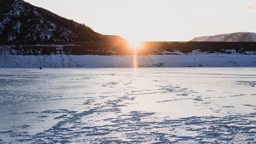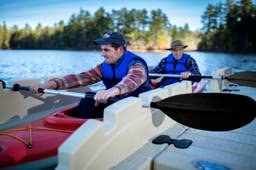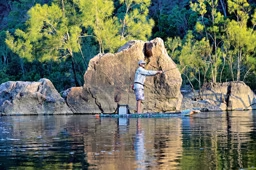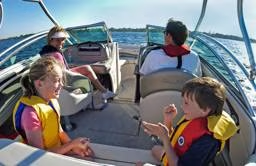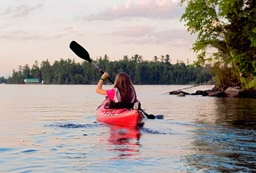
Do you have a bucket list? I don't. But recently, just after trying stand-up paddleboarding for the first time, I decided I need a bucket list for occasions just like that one. I had so much fun, that I'm inspired to try more new things during my 6th decade on this planet. I'm a big believer in setting oneself up for success. So, to help ensure my first experience on a stand-up paddleboard (SUP) would go well, I enlisted two people: a good instructor and a fun-loving compadre. The instructor was Dave Smits, owner/operator of Glacier Springs Adventure Company in the Lake Country region west of Milwaukee, Wis. And the fun-loving companion was my 19-year-old son, Cole.
A passionate instructor
Dave first tried paddleboarding a little over three years ago on Montana’s Flathead Lake. He became hooked on the sport so fast that, after just six months, he started giving lessons so he could share his love of the sport with others. To date, Dave estimates that he’s taught 800 people to SUP. When he’s not teaching cabin and lakehome owners on the 12 lakes near his Glacier Springs storefront, he’s leading extended adventures in places like Portland, Ore. The sport of SUPing couldn’t have a better representative than Dave. He’s an excellent teacher, but he’s also a Zen master and chief ambassador for his sport.
“Stand-up paddleboarding gets you out on the lake in a very quiet setting,” he says. “It’s like walking around on the lake; it slows things down. And you are on top of the water, so you get a very different perspective. You can see the wildlife on the shore, but you can also see straight down into the water, and you can see the fish.” And he thinks cabins and SUPs are a great match. “I grew up going up to the cabin every year. I think people who get into the cabin lifestyle really appreciate their surroundings. You’ve got beautiful views, and it’s all focused on enjoying that. We have such a fast-paced society, we’re all multitasking; we’ve got all our devices that connect us to everything. So stand-up paddleboarding is a way to disconnect, to get that serene feeling. It’s very calming, and when I think of a cabin, I think of that.”
Fun in numbers
It’s common for Dave to teach a group of 6–8 people. In fact, he often takes several of his rental boards to a lakehome or cabin, gives a family or private group a lesson and safety instructions, and then leaves the rented boards behind for the group to enjoy for a week. Of course, Cole and I were just a class of two. But it was a great father-and-son activity. Between us, we had a lot of experience on top of the water – kayaking, canoeing, water-skiing (me) and wakeboarding (Cole) – but this was our first time on a SUP. Going into it, I was sure Cole would do fine. Balance would be no problem for him, especially considering that his winter sport of choice is snowboarding, but I wasn’t too sure how I’d fare.
Safety tips
Stand-up paddleboard guru Dave Smits shares these simple tips for staying safe on the water:
- Be visible! SUPing is still relatively new, so boaters on your lake may not be accustomed to watching for SUPs. So, you need to be especially careful to watch for boaters. To increase your visibility, wear a brightly colored PFD and hat, and buy a brightly colored paddle. If you’re going to sit and lounge on your board, find a place near shore or a bay where you’re away from boat traffic.
- If you feel like you’re going to fall, just jump in the water so you can control the fall, and not injure yourself.
- Watch the weather; thunderstorms can come up fast, and that paddle you’re holding is a big lightning rod.
- If it’s windy, use a leash so the board doesn’t float away.
See also What You Need to Know About PFDs
What you can do
- CRUISE/SIGHTSEE. If your lake isn’t too large, work up to circumnavigating it. You can intimately discover every bay, wood duck house, and collection of lily pads.
- EXERCISE. Paddling builds core muscles! But you can even do push-ups and sit-ups on the board, practicing balance as you go.
- YOGA. Seriously, it can be done. Of course, you’ll need calm water and good balance.
- FISH. You can see the fish very well from a SUP!
- SPEND QUALITY TIME WITH YOUR DOG. Man’s best friend can be trained to ride along with you on a SUP adventure.
- RACE. Once you’ve mastered the sport, challenge yourself by entering a race. The best fringe benefit: getting to know like-minded, fun-loving adventurers.
Buying a paddleboard
Dave Smits recommends only buying boards from top-quality manufacturers. “You get what you pay for,” he says. The boards he sells in his shop run from $899–$2,500. He shares these buying tips:
- Find local resources, like a nearby board shop, and try different boards while asking about their construction.
- Decide what you want to use it for – cruising, racing, etc., so you can match the board to that use. And keep these guidelines in mind:
- Wider boards are more stable
- Narrower boards are faster
- Longer boards are also faster
- Rounded fronts give you better maneuverability for turning and for managing waves and rapids
- Stretch yourself. “Buy a board you can grow into so it will challenge you a little bit,” Dave advises.
- Buy the right board for your size (height and weight). “If the board is too small to handle your weight, you’re going to end up in the water,” Dave says.
- Buy locally. But if you decide to purchase online, make sure the shipping is insured, and don’t let the delivery driver leave until you’ve unwrapped and inspected the board.
What else do you need?
- Paddle – The less it weighs, the better.
- PFD – Buy one made for SUPing or kayaking. They have generous armholes for freedom of movement, plenty of ventilation, and usually pockets for holding things like sunscreen.
- Leash – These are important on windy days so your board doesn’t get away from you if you fall off.
- Water bottle – Stay hydrated out there.
- Sunscreen and hat – Just like with boating, you are very exposed to UV rays on top of the water.
- Cargo net – These are handy for holding gear like water bottles. Some attach to the board with suction cups.



